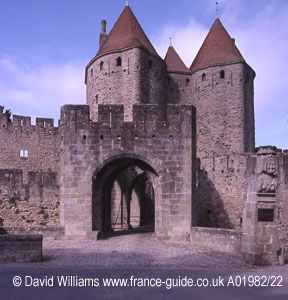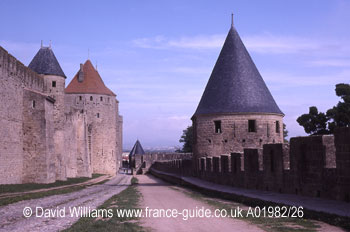 |
| This is the gateway at the Porte Narbonnaise, the main pedestrian entrance to the Cité. |
 |
| The lices (the lists) is the broad space between the inner wall (on the left) and the outer wall (on the right). |
The tall outer wall is 3km long and punctuated by fourteen massive round "pepperpot" towers. These have narrow arrow slits as well as windows from which hot oil could be poured on enemies foolish enough to launch an assault.
I gave way to a group of nine horseriders leaving the citadel, one of them busily taking pictures as he crossed the drawbridge. Once through the outer wall I was now in the lices (the lists), the broad open area between the two walls which was used for jousting. Today it was a picturesque picnic site for a large group of well-behaved primary school pupils. The inner wall towered some 15m above the children; its twenty-four towers have arrow slits and battlements to guard the lices.
The cobbled
roadway led across the lices and through the inner gate, this dark and
foreboding entrance having a large opening above it for pouring more oil
on attackers able to penetrate this far.
I was now at the foot of a cobbled road (the Rue Cros-Mayrevieille) which
narrowed as it climbed and gently curved round to the left, yet another
set of clever defensive features which had been engineered into this state-of-the-art
fortification. However, in complete contrast to all the highly-practical
medieval architecture that had been seen so far, this street was now lined
by a myriad of tourist shops selling souvenirs, local foods and designer
clothes !
Before continuing, I visited the tourist office which was located under
the inner wall. The interior of this tall stone building was circular
in shape and in the centre was a wide and very deep well. Around the walls
were alcoves which housed stone benches and these reminded me of the chapter
houses found in some medieval abbeys. Today, these alcoves were perfect
places in which to sit and study a map of the citadel before venturing
into the busy street.
| Next Page |